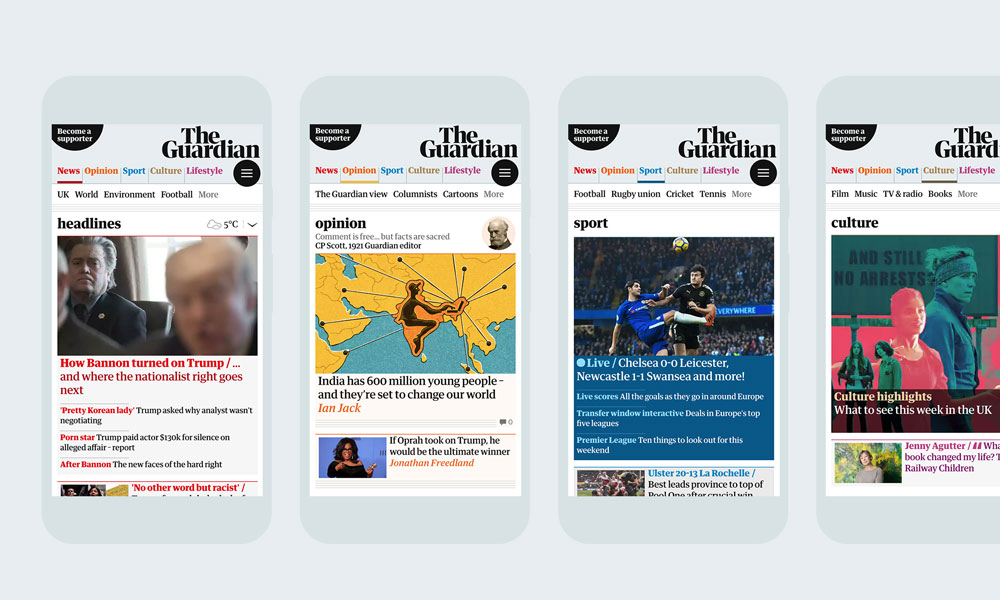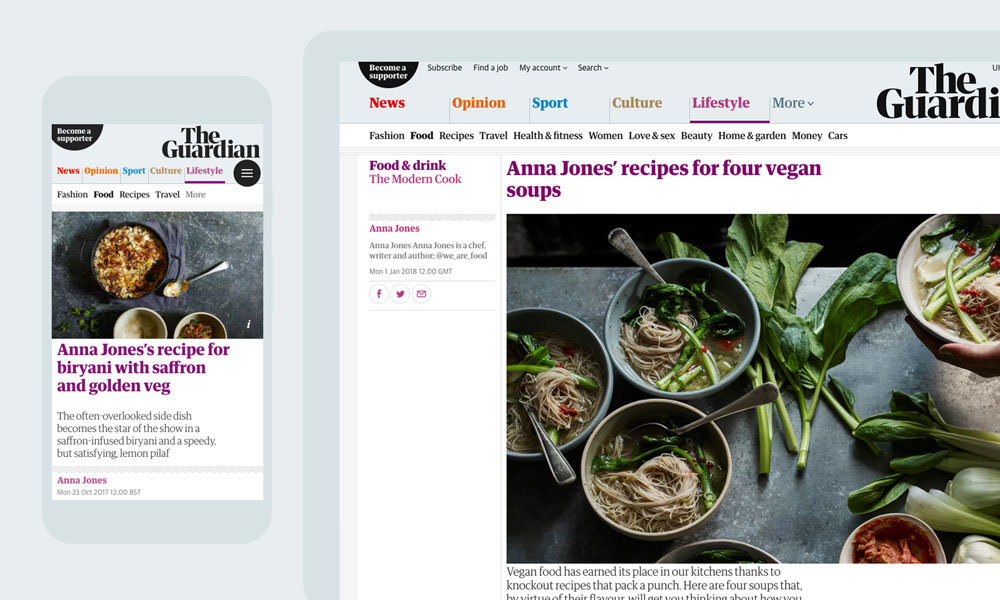The Guardian introduces tabloid format and redesigns all platforms
The tabloid has replaced the Berliner format, a new masthead has rolled out across all platforms and there’s a new pared back design offset with a colourful navigation system.

The Guardian has undergone a design overhaul, which sees a new print tabloid format introduced alongside refreshed and reorganised digital products.
Today the new tabloid edition hit news stands, replacing the Berliner format, which has been printed since 2005. The Observer will follow suit, launching in tabloid format on 21 January.
Guardian Media Group is citing cost savings of “several million” as a driver for the redesign of the newspaper, which is now cheaper to print. The publisher is aiming to break even by April 2019; the first time it has done so since the 1980s.
Masthead gives “purpose”
The redesign has been led by The Guardian’s creative director Alex Breuer who has headed up an in-house team including deputy creative director Chris Clarke and digital design director Ben Longden.
Mastheads have changed across The Guardian – in all formats – and the Observer in a bid to create a confident representation of serious trusted journalism, according to The Guardian.
Breuer says, “The bold new masthead represents The Guardian’s place and purpose in today’s turbulent news agenda.”
“Simplicity confidence and impact”
The masthead has been pared back and is now set in a new black Guardian Headline typeface, created in collaboration with Commercial Type, which was also behind the the Guardian Egyptian slab-serif typeface, created by Paul Barnes and Christian Schwartz in 2005 for use across The Guardian.
The new typeface has been chosen for its “simplicity, confidence and impact”, according to the Guardian.
Guardian Egyptian continues to be used as the main text font, although subtle changes have been made to size, line spacing and typesetting to make pages more readable.
“Readability at heart of redesign”
Meanwhile, a bolder colour palette has been introduced to delineate news, opinion, sport, arts and lifestyle in print and online.
Breuer says, “The new design has readability at its heart… With a more flexible page layout in print and online and enhanced use of photographic journalism and graphics, our new design is simple, confident and stylish.”
The new tabloid format Guardian will comprise three sections – a main section, a new section called Journal containing “opinion and ideas” and a redesigned G2 for features, arts and culture.
On Saturdays, the paper will contain five magazines – Weekend, Review, Guide, Travel and Feast – a new 24-page food magazine.
On Sundays, a refreshed Observer will feature the Observer Magazine, redesigned to make more of photography and photo-reportage, and The New Review which focuses on cultural and intellectual reporting.
Continuation of 2015 digital-first strategy
Back in 2015 Breuer led a digital first strategy, which saw The Guardian redesigned for different online platforms and this in turn influenced the print edition as the Guardian looked to create a common design language.
The big change in 2015 was introducing a horizontal “container” layout in place of columnised taxonomy, which was not serving user needs. Content started to be looked at as “slow or fast” and was curated by editors accordingly.
Readers were also given more control over which columns they wanted to see and which they wanted to conceal.
The new look and feel works with this existing functionality, navigation and curated approach, but uses single colours to familiarise readers with sections.
















Looks good on the Design Week website but in reality very disappointing when I bought a copy yesterday. If cost savings were the main driver then why sacrifice so much about what was good on the previous Berliner design? (which I thought was a great inspiration to a generation of designers myself included). If you put your hand over the name on the front it could have been The Times or Independent. They say if you cover up the brand identifier on a cover you should still be able to identify the company which doesn’t work for me in this instance. Inside the signposting on the news pages is very poor and less dynamic than previously. I think it is very telling that DW chose the best spreads but there were a whole bunch that were simply not that great. The quality of the illustrations is still as high as ever and the feature on restaurant etiquette was classic Guardian but overall, I think something is missing and it truly is a case of less is less. It must have been a very hard decision to go down that route. I would have like to have seen a cover with a single image and headline and standfirst like a magazine cover, something truly brave that stood out from the crowd. Realistically I think the days are numbered for printed newspapers unless peoples reading habits change dramatically. On the plus side the web version seems largely unaffected and looks just as good on my phone and my mac. Think it is quite telling that DW chose to feature more pages from the website than the printed editions.
It is still well ahead of the pack. I wish it well.
I can’t see how the new font makes for ‘more legibility’, particularly when the spacing on the name itself is pinched and uneven, making it look uncomfortable and ill-considered.
I really liked the content and appearance of the Guardian, and the Berliner format was so distinctive, it is a pity to see it go. Money talks.
So, does anyone care to explain how The Guardian’s new headline font is ‘confident’? And how is it simpler and how does it have more impact than the very distinctive and servicable Guardian Egyptian slab-serif?
I haven’t seen the new tabloid version yet, but the website seems to have gone backwards a tad, despite its use of pleasantly distinctive colours. However, in some details, the re-design of the website rather smacks of change for the sake of change.
For instance, there are now seemingly arbitrary numbers of multiple close-spaced horizontal rules which can appear at the head or foot of sub-sections, or occasionally under images, when sections have only a neat singular dividing line. These multiple rules seem to have no apparent purpose but to distract and irritate the reader’s eye, especially as they can render as different weights if they don’t hit pixels properly; and I am still trying to figure out their meaning.
However, I’m glad to see that the Guardian’s distinctive and readable font is still used for body text — I have a feeling that the pointy serifs on the ‘simple and impactful’ new font just won’t work at small sizes on screen. But to me it seems that the body text can often run too close under images or other visual content, especially when compared to paragraph breaks or left- and right-margins.
These are minor gripes for a fine newspaper with well honed presentation and I hope some of these lttle niggles get ironed out in time. I also hope that the new format paper finds new friends and influences more people.
Just a follow up comment to say that after a week of dull cover pages, the Saturday Weekend Guardian is back on track (why can’t the daily paper look as good?). It is well designed and the new Review supplement is excellent though still reminds me of the Berliner style. Overall, I think the general tone of the paper’s design is simplification to suit the tabloid size and the Weekend magazine harks back to the style from some years ago. However, what has not changed is the standard of journalism and reporting. One gripe is not having a full contents list. Still a great paper.
If it ain’t broke, don’t fix it.
The previous print version of this excellent newspaper was distinctive, serious and elegant, in comparison to all the rest. I’m sad to see that its now lost all that, and the body text is quite difficult to read without glasses. The online design works is far more successful, and doesn’t include the irritating ‘sticky notes’ and ‘speech bubbles’.
A specific point on colour in the we redesign: I’m surprised that two of the category colours – “Opinion” (orange), and “Culture” (brown) – in the site navigation don’t have sufficient colour contrast with the pale blue background colour to meet AA standard under Web Content Accessibility Guidelines (WCAG) 2.0, and none of them meet the AAA standard. That seems a little at odds with their rationale that “the new design has readability at its heart”.
The re-design pares back a lot of what made The Guardian distinctive – its boldness with blocks of colour and reversed out text, big pull quotes and solid lines. It’s cleaner and more refined, but somehow lacks the punch of the previous version. Adding colour to fonts may act as a cue to content / navigation but at small sizes what we have is a mass of not so readable multi-coloured text. This is where the web version falls down – coloured text is just not as efficient as those blocks of colour for indicating precisely where you are or helping you get from A to B. The masthead gets the necessary update and contrast to make it shout and be seen a bit more. And the title case makes it just a tiny bit more grown up and serious. But overall I think something’s lost in translation (to the web version). Oh and the yellow star ratings – ugh!